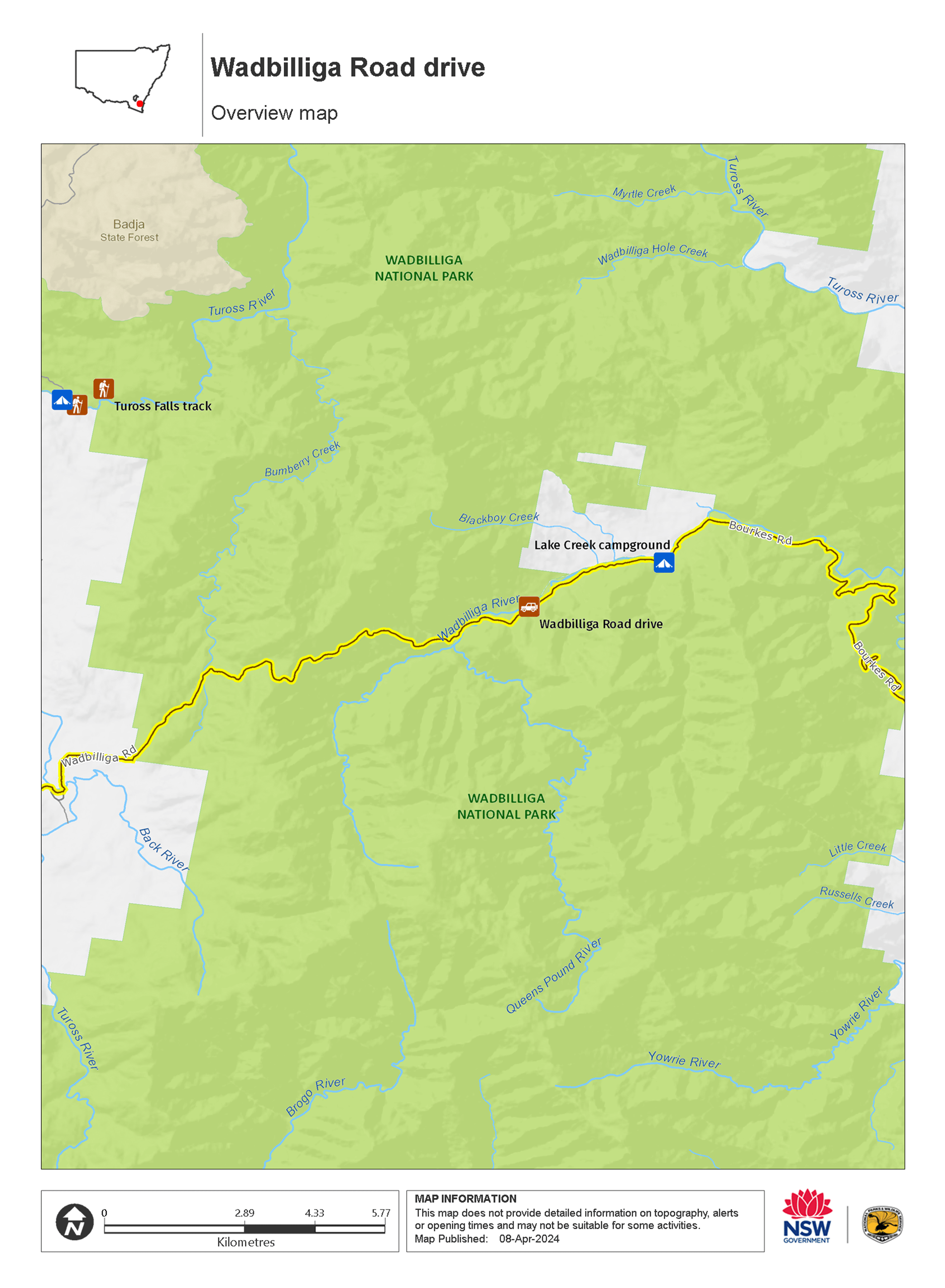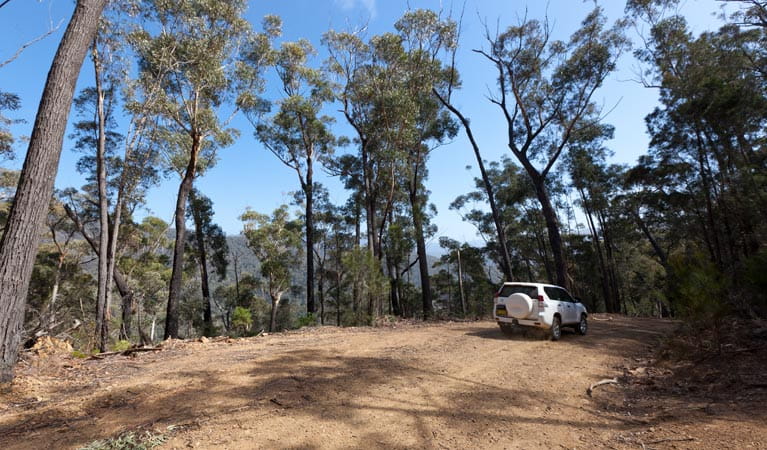Wadbilliga Road drive
Wadbilliga National Park
Overview
Wadbilliga Road drive is a 4WD touring route that takes you through an incredible range of terrain and environments within Wadbilliga National Park.
- Distance
- 35km one-way
- Time suggested
- 1hr 30min
- Grade
- Medium
- What to
bring - Hat, sunscreen
- Please note
- There is limited mobile reception in this park
- The weather in this area can be extreme and unpredictable, so please be well prepared for your visit.
For the 4WD adventurer with a bit of experience handling diverse terrain, this medium-difficulty route takes you through wild country with incredible mountain views.
Wadbilliga Road drive travels through the middle of Wadbilliga National Park, along the way you’ll traverse a wide range of environments, including coastal forest foothills, high river valley catchment plus rainforest and heathlands, all the while gaining a strong sense of being really close to true wilderness.
The drive is popular with 4WD enthusiasts, mountain bike riders, bushwalkers, remote area vehicle-based campers, and registered motorbike riders alike. It’s a terrific adventure for any outdoor enthusiast looking for an alternate route from coast to tablelands on a road less travelled.
Map

Map legend

Local alerts
For the latest updates on fires, closures and other alerts in this area, see https://www.nationalparks.nsw.gov.au/things-to-do/4wd-touring-routes/wadbilliga-road-drive/local-alerts
Park info
- in Wadbilliga National Park in the South Coast and Snowy Mountains regions
Wadbilliga National Park is always open but may have to close at times due to poor weather or fire danger.
Visitor info
All the practical information you need to know about Wadbilliga Road drive.
Getting there and parking
Get driving directions
Wadbilliga Road drive is in the Wadbilliga Road precinct of Wadbilliga National Park. To get there:
From Nimmitabel:
- Turn off the Monaro Highway onto Clarke Street
- Follow Clarke Street onto Old Bega Road and continue for approximately 4km
- Turn left into Kybean Road
- After approximately 20 km turn right into Tuross Road
- Access the start of Wadbilliga Road at Two River Plains
Alternatively, if beginning from the east:
- From the Princes Highway at Cobargo, follow the signs to Wadbilliga National Park via Wandella and Yowrie roads.
Road quality
Check the weather before you set out as Wadbilliga Road can become impassable due to flooding rivers when it rains.
Best times to visit
There are lots of great things waiting for you in Wadbilliga National Park. Here are some of the highlights.
Autumn
Walk to Tuross River Falls now that the days are getting a bit cooler. Or, follow one of the many unsealed roads through Wadbilliga on a mountain bike.
Spring
Walk to Turross River Falls for a great half-day adventure. Or, take a back-country hike to Wadbilliga Trig.
Summer
Lilo and swim in the many gorgeous pools at the cascades. Camp at the Cascades and watch for greater gliders at night.
Weather, temperature and rainfall
Summer temperature
Average
8°C and 23°C
Highest recorded
38.3°C
Winter temperature
Average
-3°C and 10°C
Lowest recorded
-10.5°C
Rainfall
Wettest month
December
Driest month
August
The area’s highest recorded rainfall in one day
256mm
Facilities
- Firewood is not supplied and may not be collected from the park
- You are encouraged to bring gas or fuel stoves, especially in summer during the fire season.
Maps and downloads
Prohibited
Pets
Pets and domestic animals (other than certified assistance animals) are not permitted. Find out which regional parks allow dog walking and see the pets in parks policy for more information.
If you're travelling through a national park or reserve on a public road you can have pets inside your vehicle. However, you must keep them inside your vehicle while driving through national parks or reserves. You must also comply with any conditions in the park’s plan of management, and you cannot stop to visit the park or use park facilities (unless for safety reasons, or to use publicly accessible toilets).
Smoking
NSW national parks are no smoking areas.
Learn more
Wadbilliga Road drive is in Wadbilliga National Park. Here are just some of the reasons why this park is special:
A botanist's wonderland

Wadbilliga has many impressive examples of open forest, woodland, heath, swamp, bogs and numerous pockets of rainforest. There are some rare species of eucalypt and acacia that do not occur anywhere else. In the Wadbilliga Valley, yellow box and forest red gum can be seen, while on the ridge tops tower large stands of silvertop ash with snow gums at high altitudes. The Wadbilliga Plateau also has dwarf she-oaks and rare stunted mallee eucalypts.
- Cascades walking track and viewing platform Cascades walking track takes you to a viewing platform with scenic views of the spectacular Tuross River which cascades into a pool.
A glimpse of gold mining history

The surrounding area has a variety of artefacts, structures and features that hark back to gold and silver mining eras, as well as the early forestry history of the local area. Today, visitors can still view various mining remains that are evidence of once arduous searches for gold and other precious materials.
A natural animal sanctuary

Due to the rugged and isolated nature of the park, animal populations here have remained relatively undisturbed. Many of the park's animals are large marsupials such as swamp wallabies, eastern grey kangaroos and wombats. There are also possums, platypuses and echidnas and one of the biggest greater glider populations in all of Australia. The birdlife is varied too, with over 120 native species. Lyrebirds are common as are many colourful and tuneful bush birds.
- Cascades walking track and viewing platform Cascades walking track takes you to a viewing platform with scenic views of the spectacular Tuross River which cascades into a pool.
- Tuross Falls walking track Turross Falls walking track is a medium difficulty 4km bushwalk at Wadbilliga National Park featuring scenic views, waterfalls, picnicking opportunities and birdwatching.
Aboriginal cultural heritage

The Yuin people consider Wadbilliga National Park a sacred place and many sites in the park are strongly associated with Dreamtime stories. The dissected, rugged escarpment contains a network of bridle tracks that follow both high country and river courses, which Aboriginal people originally used. The bridle tracks are also the most tangible historical link with the first Europeans in the area and were used for transporting produce and moving stock from one location to another. The park is abundant in traditional foods and medicines.

